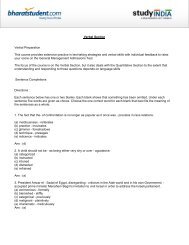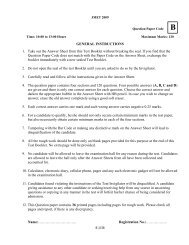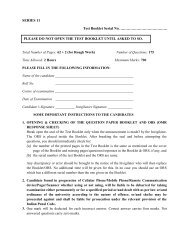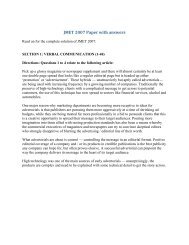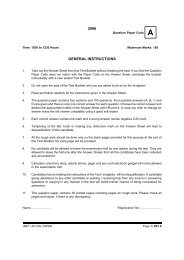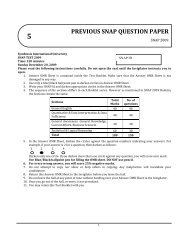PREVIOUS IIFT QUESTION PAPER
PREVIOUS IIFT QUESTION PAPER
PREVIOUS IIFT QUESTION PAPER
You also want an ePaper? Increase the reach of your titles
YUMPU automatically turns print PDFs into web optimized ePapers that Google loves.
Directions for questions 66 to 80: Read the passage<br />
carefully and answer the questions given at the end of<br />
each passage.<br />
Passage - 1<br />
Kodak decided that traditional film and prints would<br />
continue to dominate through the 1980s and that<br />
photo finishers, film retailers, and, of course, Kodak<br />
itself could expect to continue to occupy their longheld<br />
positions until l990. Kodak was right and wrong.<br />
The quality of digital cameras greatly improved.<br />
Prices plunged because the cameras generally<br />
followed Moore's Law, the famous prediction by Intel<br />
co-founder Gordon Moore in the l960s that the cost of<br />
a unit of computing power would fall by 50 percent<br />
every eighteen to twenty-four months. Cameras<br />
began to be equipped with what the industry called<br />
removable media - those little cards that hold the<br />
pictures - so pictures were easier to print or to move<br />
to other devices, such as computers. Printers<br />
improved. Their costs dropped, too. The Internet<br />
caught the popular imagination, and people began emailing<br />
each other pictures rather than print them.<br />
Kodak did little to ready itself for the onslaught of<br />
digital technology because it consistently tried to hold<br />
on to the profits from its old technology and<br />
underestimated the speed with which the new would<br />
take hold. Kodak decided it could use digital<br />
technology to enhance film, rather than replace it.<br />
Instead of preparing for the digital world, Kodak<br />
headed off in a direction that cost it dearly. ln 1988,<br />
Kodak bought Sterling Drug for $5.1 billion. Kodak<br />
had decided it was really a chemicals business, not a<br />
photography company. So, Kodak reasoned, it should<br />
move into adjacent chemical markets, such as drugs.<br />
Well, chemically treated photo paper really isn’t that<br />
similar to hormonal agents and cardiovascular drugs.<br />
The customers are different. The delivery channels<br />
are different. Kodak lost its shirt. lt sold Sterling in<br />
pieces in 1994 for about half the original purchase<br />
price. George M. C. Fisher was the new CEO of Kodak<br />
in 1993. Fisher’s solution was to hold on to the film<br />
business as long as possible, while adding a<br />
technological veneer to it. For instance, he introduced<br />
Section III (Part 1)<br />
<strong>IIFT</strong> 2010<br />
the Advantix Preview camera, a hybrid of digital and<br />
film technology. Users took pictures the way they<br />
always had, and the images were captured on film.<br />
Kodak spent more than $500 million developing<br />
Advantix, which flopped.<br />
Fisher also tried to move Kodak’s traditional retail<br />
photo-processing systems into digital world and in<br />
this regard installed tens of thousands of image magic<br />
kiosks. These kiosks came just as numerous<br />
companies introduced inexpensive, high-quality<br />
photo printers that people could use at home, which,<br />
in fact, is where customers preferred to view their<br />
images and fiddle with them. Fisher also tried to<br />
insert Kodak as an intermediary in the process of<br />
sharing images electronically. He formed<br />
partnerships that let customers receive electronic<br />
versions of their photos by e-mail and gave them<br />
access to kiosks that let them manipulate and<br />
reproduce old photographs. You don't need Kodak to<br />
upload photos to your computer and e-mail them.<br />
Fisher also formed a partnership with AOL called<br />
"You've Got Pictures." Customers would have their<br />
film developed and posted online, where friends and<br />
family could view them. Customers would pay AOL $7<br />
for this privilege, on top of the $9 paid for photo<br />
processing. However sites like Snapfish were allowing<br />
pictures to be posted online free. Fisher promised<br />
early on, that Kodak's digital-photography business<br />
would be profitable by 1997. lt wasn't. ln 1997<br />
Philippe Kahn lead the advent of cell phone camera.<br />
With the cell phone camera market growth Kodak<br />
didn't just lose out on more prints. The whole<br />
industry lost out on sales of digital cameras, because<br />
they became just a feature that was given away free<br />
on cell phones. Soon cameras became a free feature<br />
on many personal computers, too. What had been so<br />
profitable for Kodak for so long- capturing images<br />
and displaying them- was going to become essentially<br />
free.<br />
In 1999 Fisher resigned and Carp became the new<br />
CEO. In 2000, Carp‘s first year as CEO, profit was<br />
about flat, at $l.4l billion. Carp, too, retired early, at<br />
age fifty-seven. Carp had pursued Fisher's basic



